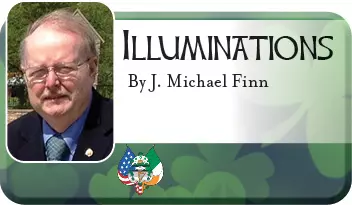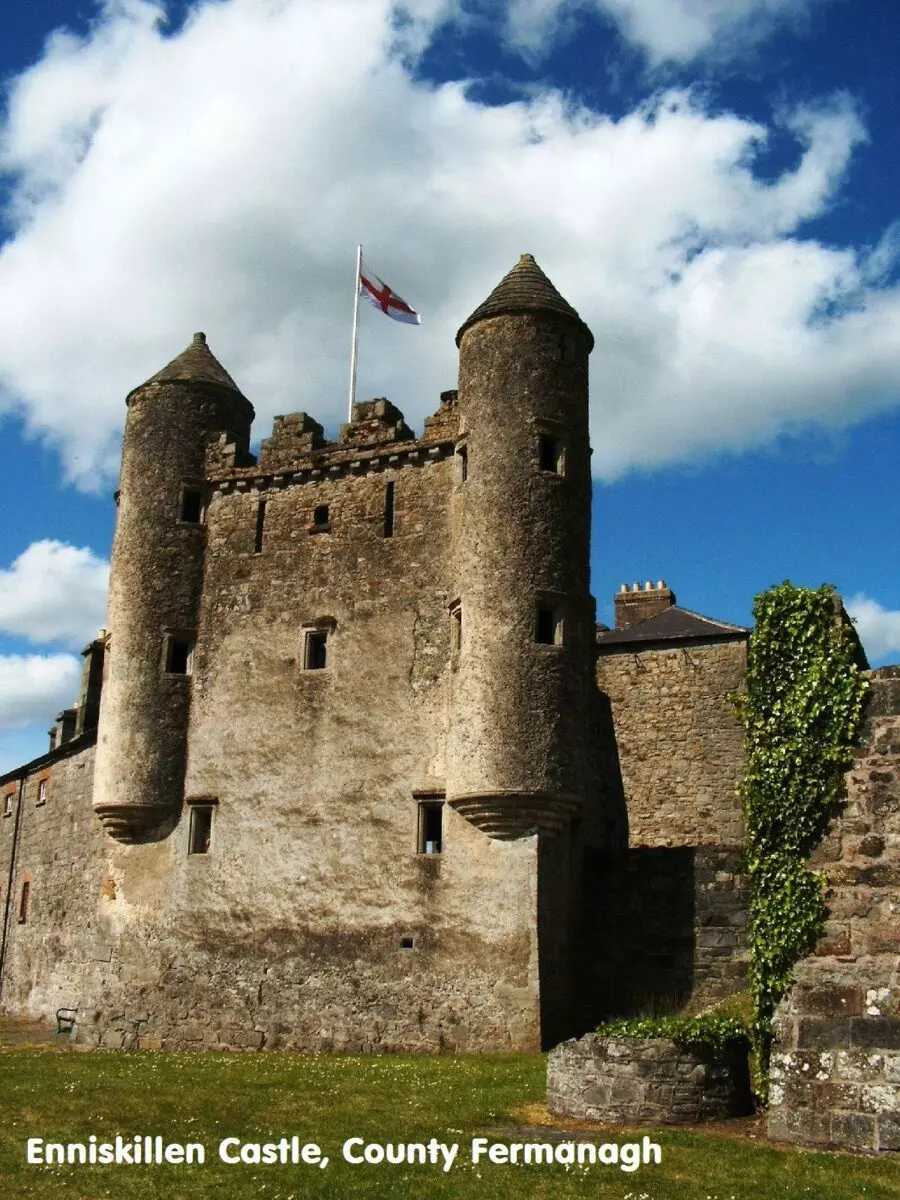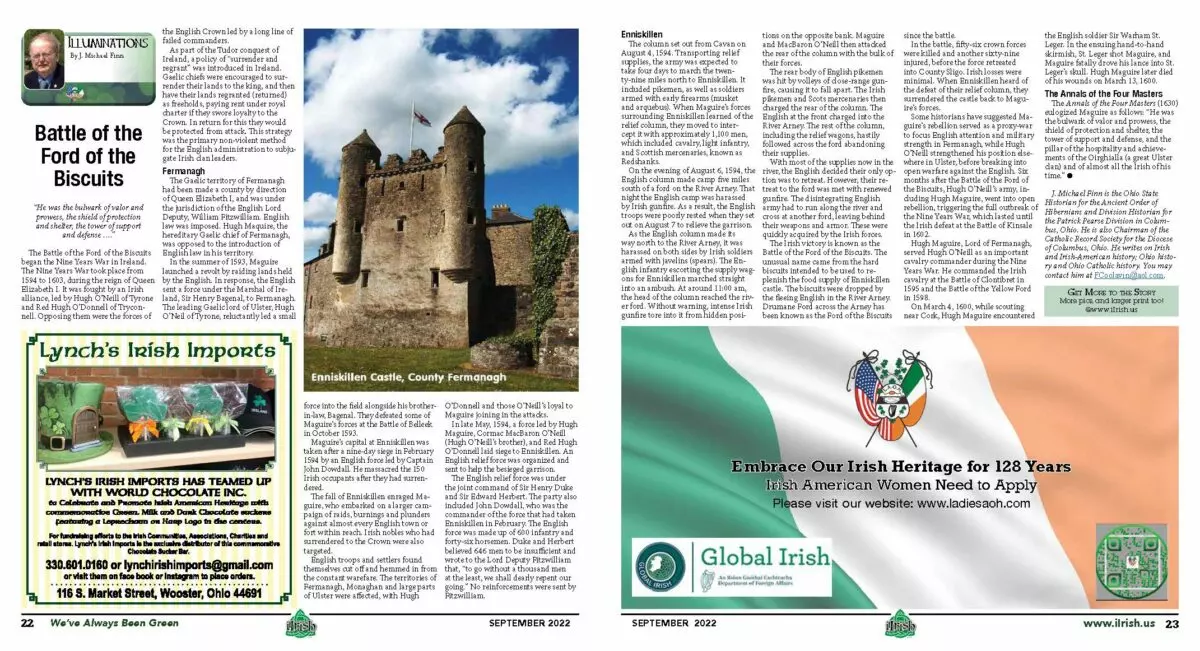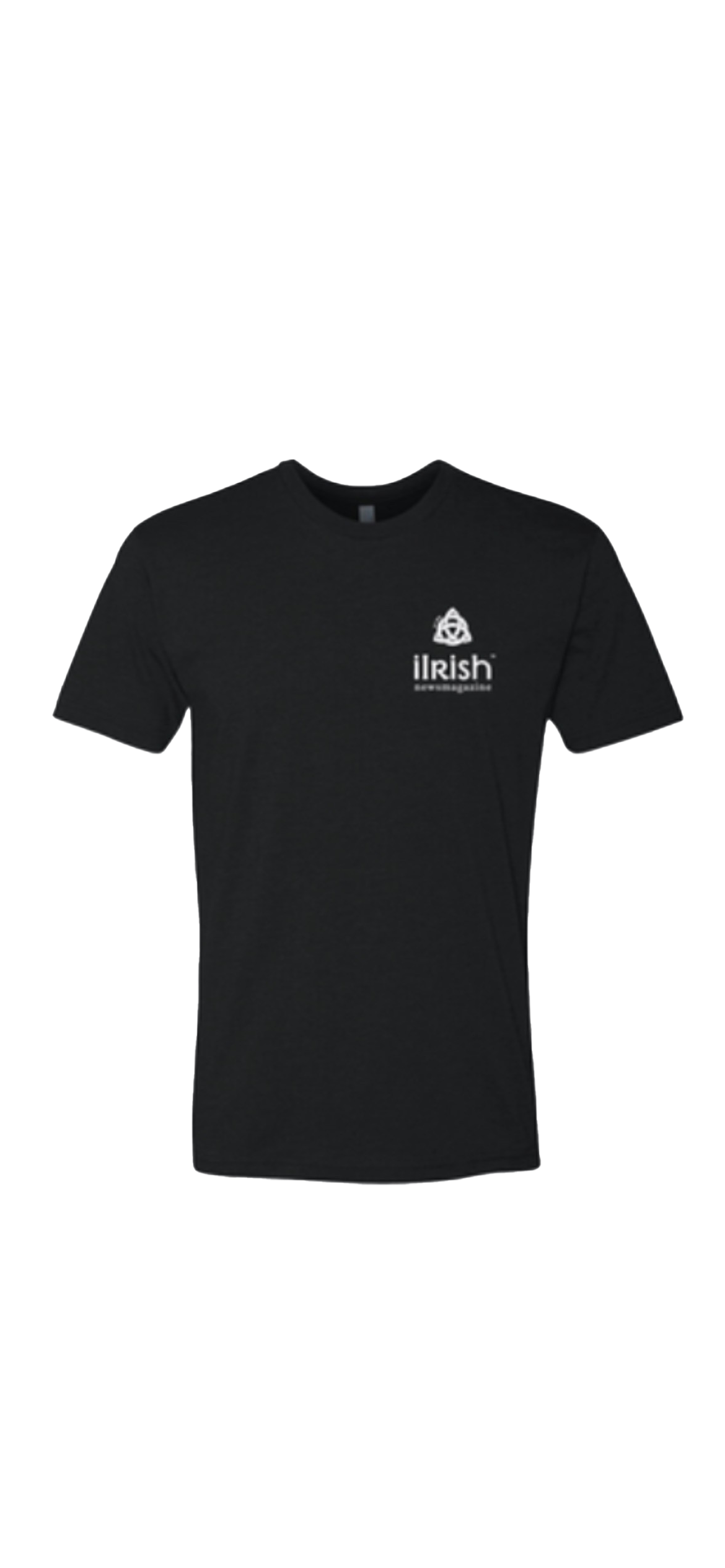
Illuminations: Battle of the Ford of the Biscuits
By: J. Michael Finn
“He was the bulwark of valor and prowess, the shield of protection and shelter, the tower of support and defense ….”
The Battle of the Ford of the Biscuits began the Nine Years War in Ireland.
The Nine Years War took place from 1594 to 1603, during the reign of Queen Elizabeth I. It was fought by an Irish alliance, led by Hugh O’Neill of Tyrone and Red Hugh O’Donnell of Tryconnell. Opposing them were the forces of the English Crown led by a long line of failed commanders.
As part of the Tudor conquest of Ireland, a policy of “surrender and regrant” was introduced in Ireland. Gaelic chiefs were encouraged to surrender their lands to the king, and then have their lands regranted (returned) as freeholds, paying rent under royal charter if they swore loyalty to the Crown. In return for this they would be protected from attack. This strategy was the primary non-violent method for the English administration to subjugate Irish clan leaders.
Fermanagh
The Gaelic territory of Fermanagh had been made a county by direction of Queen Elizabeth I, and was under the jurisdiction of the English Lord Deputy, William Fitzwilliam. English law was imposed. Hugh Maquire, the hereditary Gaelic chief of Fermanagh, was opposed to the introduction of English law in his territory.
In the summer of 1593, Maguire launched a revolt by raiding lands held by the English. In response, the English sent a force under the Marshal of Ireland, Sir Henry Bagenal, to Fermanagh. The leading Gaelic lord of Ulster, Hugh O’Neil of Tyrone, reluctantly led a small force into the field alongside his brother-in-law, Bagenal. They defeated some of Maguire’s forces at the Battle of Belleek in October 1593.
Maguire’s capital at Enniskillen was taken after a nine-day siege in February 1594 by an English force led by Captain John Dowdall. He massacred the 150 Irish occupants after they had surrendered.
The fall of Enniskillen enraged Maguire, who embarked on a larger campaign of raids, burnings and plunders against almost every English town or fort within reach. Irish nobles who had surrendered to the Crown were also targeted.
English troops and settlers found themselves cut off and hemmed in from the constant warefare. The territories of Fermanagh, Monaghan and large parts of Ulster were affected, with Hugh O’Donnell and those O’Neill’s loyal to Maguire joining in the attacks.
In late May, 1594, a force led by Hugh Maguire, Cormac MacBaron O’Neill (Hugh O’Neill’s brother), and Red Hugh O’Donnell laid siege to Enniskillen. An English relief force was organized and sent to help the besieged garrison.
The English relief force was under the joint command of Sir Henry Duke and Sir Edward Herbert. The party also included John Dowdall, who was the commander of the force that had taken Enniskillen in February. The English force was made up of 600 infantry and forty-six horsemen. Duke and Herbert believed 646 men to be insufficient and wrote to the Lord Deputy Fitzwilliam that, “to go without a thousand men at the least, we shall dearly repent our going.” No reinforcements were sent by Fitzwilliam.
Enniskillen
The column set out from Cavan on August 4, 1594. Transporting relief supplies, the army was expected to take four days to march the twenty-nine miles north to Enniskillen. It included pikemen, as well as soldiers armed with early firearms (musket and arquebus). When Maguire’s forces surrounding Enniskillen learned of the relief column, they moved to intercept it with approximately 1,100 men, which included cavalry, light infantry, and Scottish mercenaries, known as Redshanks.
On the evening of August 6, 1594, the English column made camp five miles south of a ford on the River Arney. That night the English camp was harassed by Irish gunfire. As a result, the English troops were poorly rested when they set out on August 7 to relieve the garrison.
As the English column made its way north to the River Arney, it was harassed on both sides by Irish soldiers armed with javelins (spears). The English infantry escorting the supply wagons for Enniskillen marched straight into an ambush. At around 11:00 am, the head of the column reached the river ford. Without warning, intense Irish gunfire tore into it from hidden positions on the opposite bank. Maguire and MacBaron O’Neill then attacked the rear of the column with the bulk of their forces.
The rear body of English pikemen was hit by volleys of close-range gunfire, causing it to fall apart. The Irish pikemen and Scots mercenaries then charged the rear of the column. The English at the front charged into the River Arney. The rest of the column, including the relief wagons, hastily followed across the ford abandoning their supplies.
With most of the supplies now in the river, the English decided their only option was to retreat. However, their retreat to the ford was met with renewed gunfire. The disintegrating English army had to run along the river and cross at another ford, leaving behind their weapons and armor. These were quickly acquired by the Irish forces.
The Irish victory is known as the Battle of the Ford of the Biscuits. The unusual name came from the hard biscuits intended to be used to replenish the food supply of Enniskillen castle. The biscuits were dropped by the fleeing English in the River Arney. Drumane Ford across the Arney has been known as the Ford of the Biscuits since the battle.

In the battle, fifty-six crown forces were killed and another sixty-nine injured, before the force retreated into County Sligo. Irish losses were minimal. When Enniskillen heard of the defeat of their relief column, they surrendered the castle back to Maguire’s forces.
Some historians have suggested Maguire’s rebellion served as a proxy-war to focus English attention and military strength in Fermanagh, while Hugh O’Neill strengthened his position elsewhere in Ulster, before breaking into open warfare against the English. Six months after the Battle of the Ford of the Biscuits, Hugh O’Neill’s army, including Hugh Maguire, went into open rebellion, triggering the full outbreak of the Nine Years War, which lasted until the Irish defeat at the Battle of Kinsale in 1602.
Hugh Maguire, Lord of Fermanagh, served Hugh O’Neill as an important cavalry commander during the Nine Years War. He commanded the Irish cavalry at the Battle of Clontibret in 1595 and the Battle of the Yellow Ford in 1598.
On March 4, 1600, while scouting near Cork, Hugh Maguire encountered the English soldier Sir Warham St. Leger. In the ensuing hand-to-hand skirmish, St. Leger shot Maguire, and Maguire fatally drove his lance into St. Leger’s skull. Hugh Maguire later died of his wounds on March 13, 1600.
The Annals of the Four Masters
The Annals of the Four Masters (1630) eulogized Maguire as follows: “He was the bulwark of valor and prowess, the shield of protection and shelter, the tower of support and defense, and the pillar of the hospitality and achievements of the Oirghialla (a great Ulster clan) and of almost all the Irish of his time.”
*J. Michael Finn is the Ohio State Historian for the Ancient Order of Hibernians and Division Historian for the Patrick Pearse Division in Columbus, Ohio. He is also Chairman of the Catholic Record Society for the Diocese of Columbus, Ohio. He writes on Irish and Irish-American history; Ohio history and Ohio Catholic history. You may contact him at [email protected].





